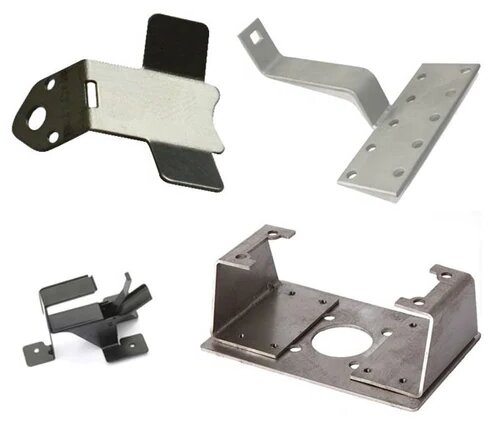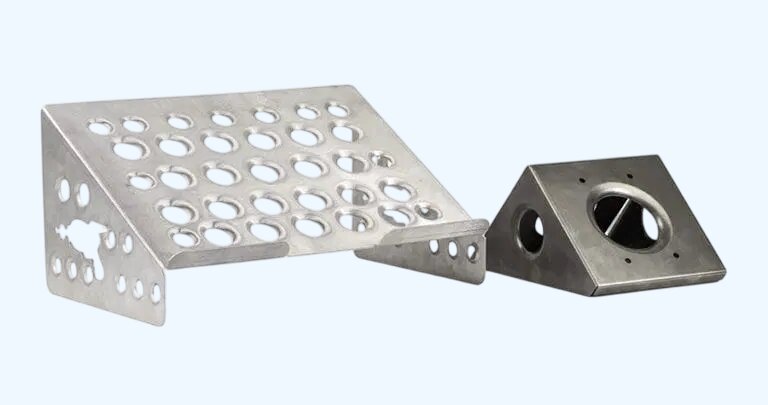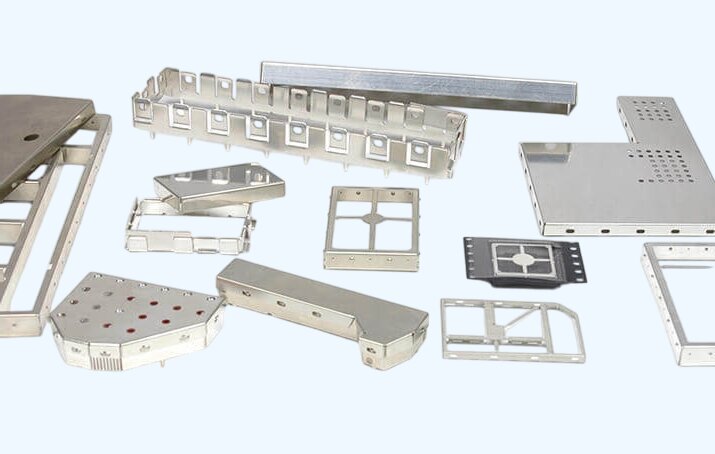W produkcji metali, cięcie i gięcie często przyciągają największą uwagę. Ale to, co naprawdę kształtuje wytrzymałość i wygląd części, następuje po tych etapach - wykończeniu. Odpowiednia obróbka powierzchni może przekształcić zwykłą część w taką, która jest odporna na rdzę, zużycie i skutki wieloletniego użytkowania. Bez tego nawet dobrze wykonane komponenty mogą ulec przedwczesnej awarii.
Wykończenie i powlekanie blach chroni części przed trudnymi warunkami środowiskowymi. Zwiększają wydajność, poprawiają wygląd i utrzymują niezawodność części w czasie. Niezależnie od tego, czy projektujesz części, kupujesz komponenty, czy zarządzasz produkcją, wybór odpowiedniego wykończenia może znacząco wpłynąć na trwałość i jakość.
W tym artykule przeanalizowano kilka standardowych metod wykańczania i powlekania, w tym malowanie proszkowe, anodowanie, galwanizację i pasywację. Każda metoda ma swoje zalety. Zrozumienie, w jaki sposób różne wykończenia wpływają na wytrzymałość, odporność na korozję i wygląd, pozwala dokonywać bardziej świadomych wyborów, które zwiększają wydajność i żywotność produktu.
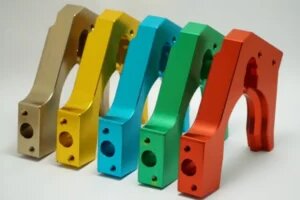
Czym jest wykańczanie blach?
Wykańczanie blach to końcowy etap produkcji, który poprawia wygląd, wytrzymałość i wydajność części. Wykorzystuje metody mechaniczne, chemiczne lub elektrochemiczne do obróbki powierzchni metalu. Procesy te usuwają drobne wady, wygładzają szorstkie obszary i przygotowują części do powlekania lub malowania. Wykończenie dodaje również warstwę ochronną, która pomaga zapobiegać rdzy, korozji i zużyciu powierzchni.
Dobre wykończenie może zmienić goły metal w część gotową do długotrwałego użytkowania. Może zatrzymać utlenianie w wilgotnych lub zewnętrznych warunkach i zmniejszyć tarcie między ruchomymi częściami. Wykończenia ułatwiają również czyszczenie części i pomagają im dłużej zachować swój wygląd.
Typowe rodzaje wykończenia blach
Każda metoda wykończenia ma swoje mocne strony w zależności od funkcji części i środowiska pracy. Poniżej znajdują się niektóre z najbardziej popularnych i skutecznych wykończeń stosowanych do części blaszanych.
Wydmuchiwanie perełek
Wydmuchiwanie kulek wykorzystuje delikatne szklane kulki i sprężone powietrze do czyszczenia i wygładzania powierzchni metalowych. Proces ten usuwa rdzę, utlenianie i ślady obróbki, zachowując dokładne wymiary części. Tworzy matową lub satynową powierzchnię o chropowatości około Ra 1,0-3,0 μm, co czyni ją odpowiednią bazą do późniejszego powlekania lub malowania.
Jest ona często stosowana na stali nierdzewnej, aluminium i stali miękkiej. Obróbka strumieniowo-ścierna zwiększa przyczepność powłoki i zapewnia częściom czysty, równomierny wygląd, który ukrywa drobne niedoskonałości powierzchni. Jest to doskonały wybór, gdy wymagany jest spójny wygląd i delikatna tekstura.
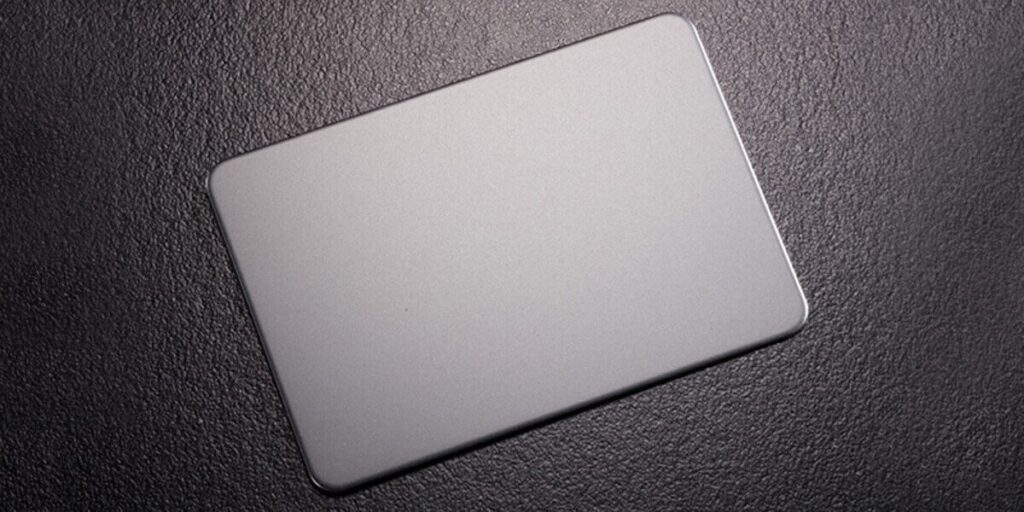
Malowanie proszkowe
Malowanie proszkowe polega na natryskiwaniu naładowanych cząstek proszku na uziemioną metalową powierzchnię, a następnie utwardzaniu ich w piecu w temperaturze 180-200°C. Stopiony proszek tworzy ciągłą, trwałą powłokę o grubości 60-120 μm.
Powłoka ta zapewnia doskonałą ochronę przed korozją, uderzeniami i promieniowaniem UV, dzięki czemu nadaje się zarówno do zastosowań wewnętrznych, jak i zewnętrznych. Części malowane proszkowo zachowują swój kolor i połysk przez lata, wykazując minimalne blaknięcie lub łuszczenie. Dzięki niezliczonej liczbie kolorów i tekstur do wyboru, wykończenie to jest szeroko stosowane w obudowach, meblach i częściach maszyn, które wymagają zarówno wytrzymałości, jak i atrakcyjności wizualnej.
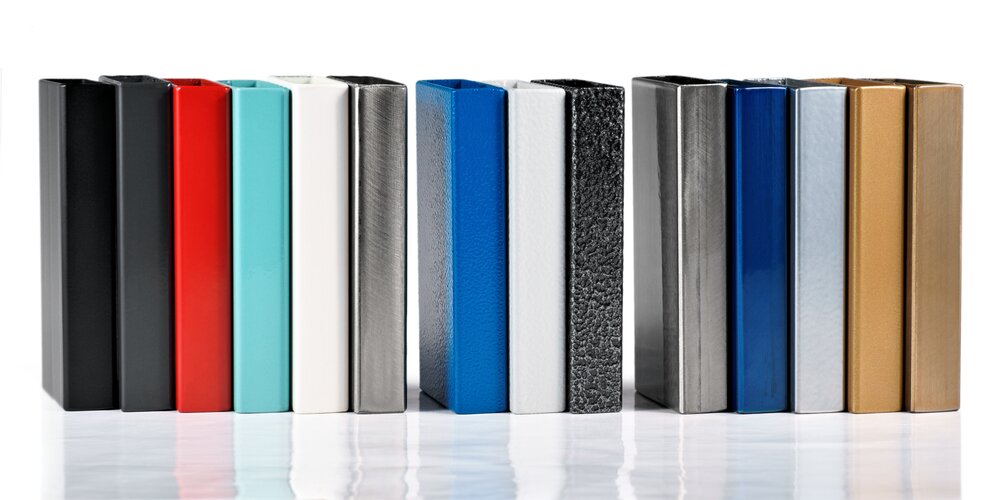
Malowanie
Malowanie Dodaje cienką 30-50 μm warstwę płynnej powłoki w celu ochrony metalu i dodania koloru. Powierzchnia jest czyszczona i czasami pokrywana warstwą fosforanu w celu zwiększenia przyczepności farby. Części są następnie wypalane w temperaturze 120-150°C w celu utwardzenia farby i zwiększenia jej trwałości.
Różne farby są używane do różnych celów:
- Farba epoksydowa oferuje wysoką odporność chemiczną i dobrze nadaje się do maszyn przemysłowych.
- Farba akrylowa Szybko schnie i dobrze sprawdza się w przypadku mebli lub ekspozycji wewnątrz pomieszczeń.
- Farba poliuretanowa jest odporny na światło słoneczne i deszcz, dzięki czemu idealnie nadaje się do zastosowań zewnętrznych.
Malowanie jest elastyczne pod względem koloru i opcji wykończenia oraz opłacalne w przypadku prototypów lub małych partii. Chociaż nie jest tak wytrzymałe jak malowanie proszkowe, zapewnia atrakcyjną, łatwą do czyszczenia powierzchnię z solidną ochroną przed warunkami atmosferycznymi.
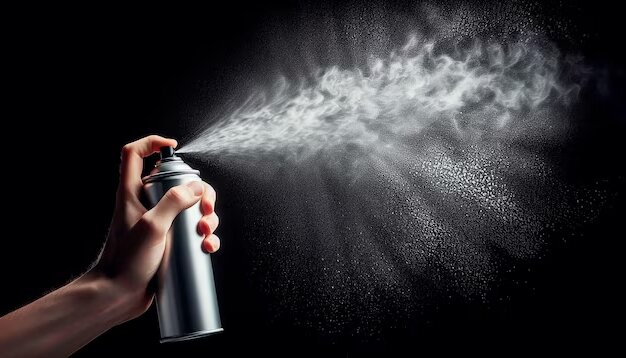
Galwanotechnika
Galwanotechnika wykorzystuje prąd elektryczny do pokrycia części cienką warstwą innego metalu, takiego jak cynk, nikiel lub chrom. Powłoka ma zwykle grubość 2-25 μm.
- Cynkowanie zapewnia odporność na korozję i błyszczący srebrny wygląd.
- Niklowanie zwiększa twardość i odporność na zużycie.
- Chromowanie zapewnia lustrzane wykończenie i wysoką trwałość.
Części galwanizowane są powszechnie stosowane w motoryzacji, elektronice i produktach dekoracyjnych, gdzie istotny jest zarówno wygląd, jak i wydajność.
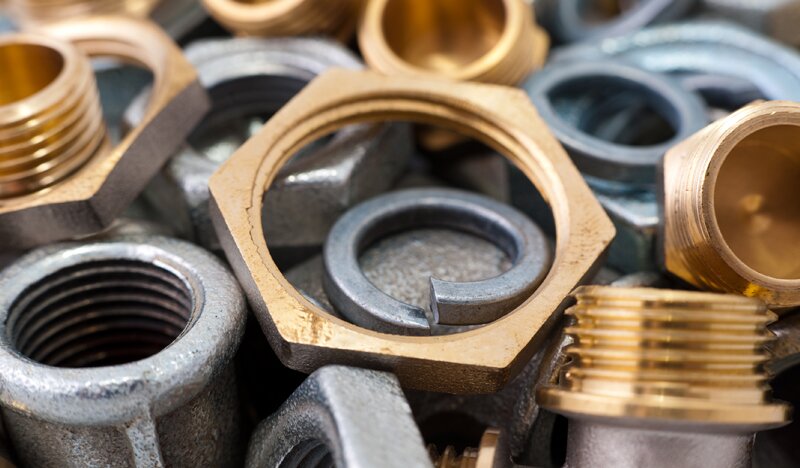
Anodowanie
Anodowanie jest stosowany głównie na aluminium w celu poprawy odporności na korozję i twardości powierzchni. Część aluminiowa jest umieszczana w kąpieli kwasowej, a prąd elektryczny tworzy ściśle związaną warstwę tlenku o grubości 10-100 μm.
Anodowane aluminium może być barwione na różne kolory. Ponieważ barwnik jest wchłaniany przez warstwę tlenku, nie odpryskuje ani nie łuszczy się. Następnie powierzchnia jest uszczelniana w gorącej wodzie, aby zamknąć pory i zablokować kolor.
- Anodowanie typu II (kwas siarkowy) jest powszechny w zastosowaniach konsumenckich i architektonicznych.
- Anodowanie typu III, znane również jako twarde anodowanie, tworzy grubszą, twardszą warstwę dla części lotniczych i przemysłowych.
Anodyzowane części oferują również silną izolację elektryczną, dzięki czemu nadają się do obudów, radiatorów i komponentów elektronicznych.

Pasywacja i powłoka chemiczna
Pasywacja zwiększa odporność stali nierdzewnej na korozję poprzez usuwanie wolnego żelaza i zanieczyszczeń z powierzchni. Tworzy cienką, niewidoczną warstwę tlenku bez zmiany wyglądu części.
W przypadku aluminium podobną ochronę zapewnia powłoka chemiczna, taka jak konwersja chromianowa. Powłoki te są delikatne, zwykle mierzą mniej niż jeden μm i utrzymują przewodność elektryczną, jednocześnie będąc odpornymi na utlenianie. Obie metody są powszechnie stosowane w obudowach i zespołach elektrycznych, w których przewodność i odporność na korozję są niezbędne.
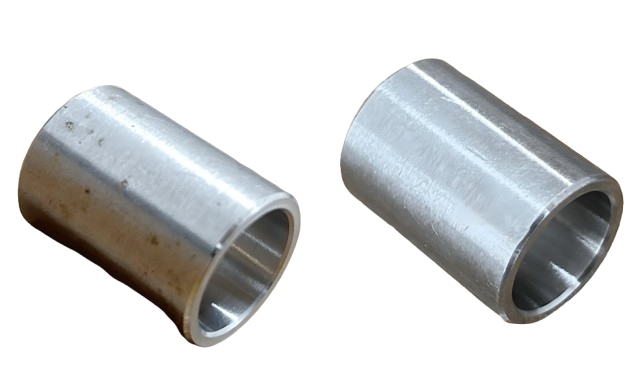
Powłoka elektroniczna
E-powłoka, znana również jako powłoka elektroforetycznarównomiernie nakłada farbę za pomocą pola elektrycznego. Część jest zanurzana w kąpieli farby na bazie wody, ładowana, a następnie wypalana w temperaturze 160-190°C. Końcowa powłoka ma zazwyczaj grubość 20-35 μm, pokrywając nawet skomplikowane kształty i ciasne narożniki.
E-powłoka oferuje gładkie, błyszczące wykończenia o doskonałej odporności na korozję. Jest szeroko stosowany w przemyśle motoryzacyjnym i produkcji urządzeń, ponieważ zapewnia spójne pokrycie, silną przyczepność oraz odporność na odpryski i blaknięcie.
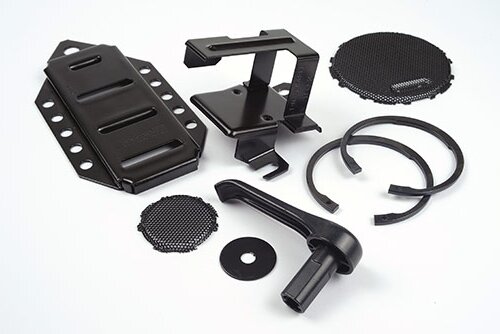
Czernienie na gorąco
Czernienie na gorąco, zwane również powlekaniem czarnym tlenkiemtworzy cienką czarną warstwę na stali lub żelazie. Części są zanurzane w serii podgrzewanych kąpieli chemicznych, które tworzą warstwę tlenku o grubości około 1 μm.
Wykończenie to zapewnia łagodną ochronę przed korozją, redukuje odblaski i nadaje jednolity ciemny wygląd. Jest powszechnie stosowany do narzędzi, elementów złącznych i precyzyjnych części, które wymagają czystego, profesjonalnego wyglądu przy zachowaniu wąskich wymiarów.
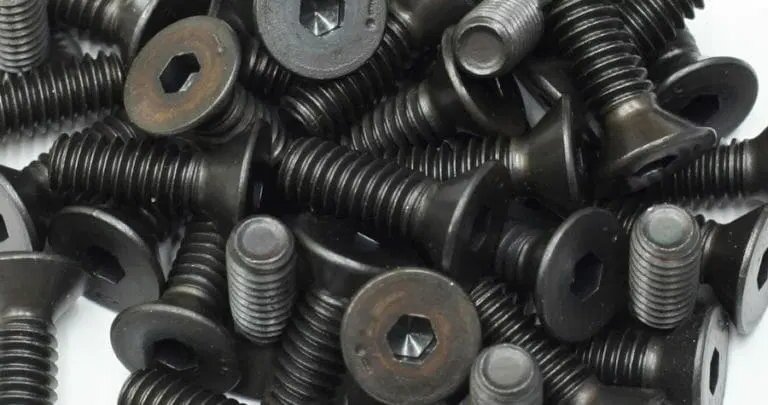
Jak wykańczanie blach zwiększa wydajność?
Wykończenie powierzchni nie tylko sprawia, że części wyglądają dobrze - ma bezpośredni wpływ na ich wydajność i trwałość. Każdy rodzaj obróbki powierzchni odgrywa kluczową rolę w ochronie części i minimalizacji długoterminowych kosztów.
Odporność na korozję i zużycie
Części metalowe często narażone są na trudne warunki, takie jak wilgoć, chemikalia lub tarcie. Bez odpowiedniego wykończenia, czynniki te mogą powodować rdzewienie, utlenianie lub zużycie powierzchni. Wykończenia takie jak malowanie proszkowe, anodowanie i galwanizacja tworzą warstwę ochronną, która zapobiega tym problemom. Przykładowo, stalowa obudowa malowana proszkowo może być odporna na warunki pogodowe na zewnątrz przez lata, podczas gdy anodyzowane aluminium pozostaje stabilne w wilgotnym lub morskim środowisku.
Wykończenia chronią również przed zużyciem mechanicznym w wyniku wielokrotnego kontaktu lub ruchu. Twarde anodowanie i niklowanie sprawiają, że powierzchnie są bardziej skomplikowane i odporne na zarysowania lub ścieranie. Ograniczając korozję i zużycie, wykończenie powierzchni pomaga wydłużyć żywotność części i obniżyć koszty konserwacji - co jest kluczową zaletą zarówno w produkcji, jak i codziennym użytkowaniu.
Korzyści estetyczne i brandingowe
Wysokiej jakości wykończenie nadaje produktowi profesjonalny, wartościowy wygląd. Gładkie, równomierne powłoki sprawiają, że części wyglądają na precyzyjne i trwałe, co wzmacnia zaufanie klientów do marki. Wykończenia, takie jak malowanie proszkowe i malowanie, są dostępne w szerokiej gamie kolorów i tekstur, zapewniając firmom elastyczność w dopasowaniu do ich celów związanych z brandingiem i projektowaniem.
W przypadku produktów konsumenckich wygląd i dotyk mają równie duże znaczenie jak funkcjonalność. Satynowana powierzchnia lub błyszcząca powłoka proszkowa świadczą o jakości i dbałości o szczegóły. Oprócz wyglądu, wykończenia zapobiegają również blaknięciu i odbarwieniom, pomagając produktom zachować czysty wygląd przez długi czas.
Parametry elektryczne i termiczne
Niektóre wykończenia zwiększają zdolność części do radzenia sobie z elektrycznością lub ciepłem. Galwanizacja niklem lub miedzią zwiększa przewodność elektryczną, dzięki czemu idealnie nadaje się do stosowania w terminalach, złączach i komponentach elektronicznych. Z drugiej strony, anodyzowane aluminium zapewnia izolację tam, gdzie części muszą blokować przepływ prądu, np. w obudowach lub radiatorach.
Wykończenia mogą również poprawić transfer ciepła. Powłoki ochronne, które zmniejszają utlenianie, utrzymują stabilną wydajność termiczną, szczególnie w przypadku komponentów takich jak zasilacze lub moduły LED. Wybór odpowiedniego wykończenia w oparciu o potrzeby elektryczne lub termiczne zapewnia bezpieczne i wydajne działanie części w rzeczywistych warunkach.
Jak wybrać odpowiednie wykończenie blachy?
Każda część ma inne potrzeby w zakresie wydajności, a najlepsze wykończenie zależy od tego, gdzie i jak będzie używana. Właściwy wybór poprawia zarówno funkcjonalność, jak i wygląd. Oto główne punkty, które należy wziąć pod uwagę przy wyborze wykończenia.
Jak dopasować wykończenie do materiału?
Różne metale różnie reagują na metody wykańczania. Materiał bazowy określa, jakie zabiegi będą dobrze wiązać i zapewniać trwałą ochronę.
Aluminium najlepiej współpracuje z anodowaniem, które zwiększa twardość i oferuje szereg opcji kolorystycznych. Dobrze łączy się również z malowaniem proszkowym lub malowaniem, gdy wymagana jest dodatkowa odporność na korozję lub dekoracja.
Stal nierdzewna czerpie największe korzyści z pasywacji i obróbki strumieniowo-ściernej, które czyszczą i chronią bez zmniejszania jej naturalnej odporności na korozję. Aby uzyskać ciemniejszy lub bardziej błyszczący wygląd, można zastosować powlekanie elektrolityczne lub elektropolerowanie.
Stal miękka wymaga silniejszej ochrony, ponieważ łatwo rdzewieje. Cynkowanie, malowanie proszkowe i malowanie to powszechne wybory, które tworzą solidną barierę przed wilgocią i utlenianiem.
Miedź i mosiądz są często używane z przezroczystymi powłokami lub niklowaniem, aby zapobiec matowieniu, zachowując jednocześnie swój metaliczny kolor. Ponieważ każdy metal reaguje inaczej na swoje środowisko, wybór kompatybilnego wykończenia zapewnia zarówno długotrwałą wydajność, jak i atrakcyjny wygląd.
| Zakończenie | Stal węglowa | Stal nierdzewna | Aluminium | Stopy miedzi | Stal galwanizowana |
|---|---|---|---|---|---|
| Czarny tlenek | Nadaje się do narzędzi, osprzętu i elementów złącznych; zapewnia łagodną odporność na korozję. | Zazwyczaj nie używane. | Nieodpowiednie. | Nieodpowiednie. | Nieodpowiednie. |
| Galwanotechnika | Stosowany do powłok cynkowych, niklowych lub chromowych w celu poprawy wyglądu i ochrony przed korozją. | Zwykle niepotrzebne ze względu na naturalną odporność na korozję. | Nie są powszechnie używane. | Często używany do dekoracyjnych lub ochronnych wykończeń niklowych i chromowanych. | Niezalecane. |
| Anodowanie | Nieodpowiednie. | Nieodpowiednie. | Powszechnie stosowany do części aluminiowych; poprawia odporność na zużycie i stabilność koloru. | Nieodpowiednie. | Nieodpowiednie. |
| Malowanie | Powszechne, niedrogie wykończenie; zapewnia ochronę przed korozją i warunkami atmosferycznymi. | Działa jako dodatkowa warstwa barierowa; konfigurowalne kolory. | Elastyczne wykończenie dla prototypów i produktów konsumenckich. | Zapewnia kolor i odporność na matowienie. | Często używany do części zewnętrznych wymagających jednolitości wizualnej. |
| Malowanie proszkowe | Zapewnia trwałą i odporną na uderzenia powłokę; stosowana do maszyn i części zewnętrznych. | Idealny do zastosowań przemysłowych wymagających zarówno trwałości, jak i wyglądu. | Popularne wykończenie dekoracyjne z silną ochroną antykorozyjną. | Stosowany dla długotrwałej ochrony koloru. | Zwiększa odporność na korozję wstępnie powlekanych części. |
| Pasywacja | Nie dotyczy. | Poprawia odporność na korozję i stabilność powierzchni. | Nieodpowiednie. | Nieodpowiednie. | Nieodpowiednie. |
| Polerowanie | Zwiększa gładkość powierzchni i poprawia wygląd. | Wykończenie lustrzane lub szczotkowane. | Poprawia współczynnik odbicia i gładkość. | Używany do dekoracyjnego wzmocnienia. | Poprawia wygląd i czystość powierzchni. |
| Piaskowanie | Czyści utlenione powierzchnie i przygotowuje je do malowania. | Usuwa kamień i zwiększa przyczepność powierzchni. | Tworzy jednolitą matową teksturę. | Służy do czyszczenia i teksturowania przed wykończeniem. | Przygotowuje powierzchnię do malowania lub powlekania proszkowego. |
Jakie jest środowisko pracy części?
Środowisko ma znaczący wpływ na żywotność ryb. Części używane w środowisku wilgotnym, słonym lub bogatym w chemikalia wymagają wysokiej odporności na korozję. Malowanie proszkowe i anodowanie dobrze nadają się do zastosowań zewnętrznych lub w pobliżu wody. W przypadku zastosowań wewnętrznych, galwanizacja lub pasywacja zazwyczaj zapewniają wystarczającą ochronę.
Gdy części są narażone na ciepło, tarcie lub kontakt z innymi komponentami, należy wybrać wykończenia, które są odporne na zużycie mechaniczne. W przypadku sprzętu medycznego lub spożywczego idealne są gładkie i łatwe do czyszczenia wykończenia, takie jak polerowana stal nierdzewna lub anodowane aluminium.
Jakie są Twoje potrzeby w zakresie wydajności?
Każde wykończenie oferuje inne korzyści mechaniczne i funkcjonalne. Odporność na ścieranie zapewnia twarde anodowanie lub niklowanie. Aby uzyskać przewodność elektryczną, wybierz cynkowanie lub powłokę chemiczną, która utrzymuje dobry kontakt między metalowymi powierzchniami.
Jeśli celem jest spójność wizualna, powlekanie elektrostatyczne i malowanie proszkowe zapewniają jednolity kolor i połysk. Części ruchome korzystają z gładszych powierzchni, które zmniejszają tarcie i zapobiegają przedwczesnemu zużyciu. Dopasowanie wykończenia do przeznaczenia części pomaga utrzymać wydajność i niezawodność przez długi czas.
Jakie są ograniczenia budżetowe i czasowe?
Koszty i harmonogram często wpływają na decyzje dotyczące wykończenia. Malowanie natryskowe i piaskowanie są niedrogie i szybkie, dzięki czemu nadają się do prototypów lub małych serii produkcyjnych. Malowanie proszkowe i powlekanie elektryczne wymagają dłuższego czasu przygotowania, ale są bardziej wydajne w przypadku produkcji masowej.
Jeśli czas jest ograniczony, wybierz wykończenia o krótkim czasie utwardzania lub schnięcia. Aby uzyskać długoterminowe oszczędności, inwestowanie w trwałe wykończenia może zmniejszyć przyszłe koszty konserwacji i wymiany.
Jaki wygląd chcesz uzyskać?
Wykończenie powierzchni definiuje wygląd i sposób użytkowania produktu. Matowe lub szczotkowane wykończenie nadaje industrialny styl, podczas gdy chromowanie lub błyszcząca powłoka proszkowa tworzy nowoczesny, wysokiej klasy wygląd.
Kolor, połysk i tekstura wpływają na to, jak klienci postrzegają jakość. Projektanci często wybierają wykończenia, które pasują do wizerunku ich marki, jednocześnie zachowując równowagę między wydajnością a kosztami.
Możliwości wykańczania i powlekania Shengen
W Shengen wspieramy projekty od prototypu do produkcji. Oferujemy kompletny zestaw usług wykańczania i powlekania. Koncentrujemy się na stabilnej jakości i krótkim czasie realizacji.
Uruchomiliśmy kilka Wewnętrzne opcje wykończenia aby zachować kontrolę i prędkość:
- Malowanie proszkowe: Oferujemy różne tekstury i poziomy połysku. Powłoka dobrze przylega i jest trwała na zewnątrz. Nadaje się do obudów, ram i części konstrukcyjnych.
- Obraz: Szybko dopasowujemy kolory do prototypów i małych serii. Wykończenie wygląda gładko i czysto.
- Śrutowanie i piaskowanie: Czyścimy i wygładzamy powierzchnię przed malowaniem. Matowa tekstura pomaga farbie lub proszkowi lepiej przylegać.
- Polerowanie i szczotkowanie: Poprawiamy wygląd, usuwamy drobne zadrapania i uzyskujemy satynowe lub lustrzane wykończenie.
Współpracujemy również z zaufanymi warsztatami obróbki powierzchni na specjalne potrzeby:
- Anodowanie (typy II i III): Ulepszamy aluminium, zwiększając jego odporność na zużycie i korozję. Oferujemy przezroczyste, czarne i niestandardowe kolory.
- Galwanotechnika: Dodajemy cynk, nikiel lub chrom w celu ochrony lub poprawy wyglądu. W razie potrzeby poprawiamy również przewodność.
- E-Coating: Zapewniamy gładką, równomierną powłokę na złożonych kształtach. Rezultat wygląda na wysokiej jakości i spójny.
- Pasywacja: Obrabiamy stal nierdzewną w celu zwiększenia jej odporności na korozję bez zmiany jej wyglądu lub tekstury powierzchni.
Możesz przesłać nam swoje rysunki i specyfikacje. Nasz zespół dokona przeglądu materiałów, celów i budżetu. Przygotujemy dokładną wycenę wraz z czasem realizacji i uwagami technicznymi.
Nasi inżynierowie mogą pomóc w porównaniu dostępnych opcji. Możemy wyjaśnić, kiedy malowanie proszkowe przewyższa anodowanie, a także kiedy inne wykończenie jest lepszym rozwiązaniem. Podaj szczegóły swojej części, a my zapewnimy bezpłatną konsultację i wycenę obróbki powierzchni.
Najczęściej zadawane pytania dotyczące wykańczania blach
Poniżej znajdują się odpowiedzi na niektóre często zadawane pytania dotyczące wykańczania i powlekania powierzchni blach. Szczegóły te mogą pomóc w zaplanowaniu procesu wykańczania z jasnymi oczekiwaniami.
Czy mogę dostosować kolor lub teksturę wykończenia?
Tak. Oferujemy pełną personalizację kolorystyczną zgodnie ze standardami RAL lub Pantone. Malowanie proszkowe, malowanie i anodowanie pozwala uzyskać szeroką gamę kolorów i tekstur powierzchni - od miękkich, matowych wykończeń po błyszczący połysk. W celu dopasowania marki możemy przeprowadzić testy próbek przed rozpoczęciem produkcji, aby potwierdzić dokładność i spójność kolorów.
Jak grube są zazwyczaj nakładane powłoki?
Grubość powłoki zależy od rodzaju wykończenia i potrzeb funkcjonalnych:
- Malowanie proszkowe: 60-120 μm
- Malowanie natryskowe: 30-50 μm
- Anodowanie: 10-100 μm (w zależności od typu II lub typu III)
- Galwanotechnika: 2-25 μm
- E-Coating: 20-35 μm
Nasi technicy sprawdzają grubość powłoki podczas produkcji, aby zapewnić równomierne pokrycie i odpowiednią ochronę.
Jaki jest typowy czas oczekiwania na wykończenie?
Czas realizacji zależy od procesu i wielkości zamówienia. Proste wykończenia, takie jak piaskowanie lub malowanie, zajmują zwykle 3-5 dni w przypadku małych partii. Bardziej zaawansowane wykończenia, takie jak anodowanie lub galwanizacja, mogą zająć 7-10 dni, w tym przygotowanie powierzchni i kontrola. Duże serie produkcyjne są planowane w celu zapewnienia zarówno wysokiej jakości, jak i szybkiej realizacji.
Czy części można w razie potrzeby przerobić lub ponownie wykończyć?
Tak, w większości przypadków. Powłoki takie jak farba, powłoka proszkowa lub anodowanie mogą zostać usunięte i ponownie nałożone. Dokładny proces zależy od materiału i rodzaju wykończenia. Na przykład cienkie części aluminiowe wymagają ostrożnego obchodzenia się, aby zapobiec uszkodzeniom. Przed przeróbką nasz zespół sprawdza każdą część, aby znaleźć najbezpieczniejsze i najbardziej opłacalne rozwiązanie.
Czy oferujecie certyfikaty lub testy jakości?
Tak. Wszystkie gotowe części przechodzą kontrolę przyczepności, grubości i powierzchni przed wysyłką. Na życzenie możemy dostarczyć certyfikaty RoHS, wyniki testów w mgle solnej i raporty twardości, aby spełnić określone wymagania jakościowe projektu.
Hej, jestem Kevin Lee

Przez ostatnie 10 lat byłem zanurzony w różnych formach produkcji blach, dzieląc się tutaj fajnymi spostrzeżeniami z moich doświadczeń w różnych warsztatach.
Skontaktuj się z nami

Kevin Lee
Mam ponad dziesięcioletnie doświadczenie zawodowe w produkcji blach, specjalizując się w cięciu laserowym, gięciu, spawaniu i technikach obróbki powierzchni. Jako dyrektor techniczny w Shengen, jestem zaangażowany w rozwiązywanie złożonych wyzwań produkcyjnych i napędzanie innowacji i jakości w każdym projekcie.

